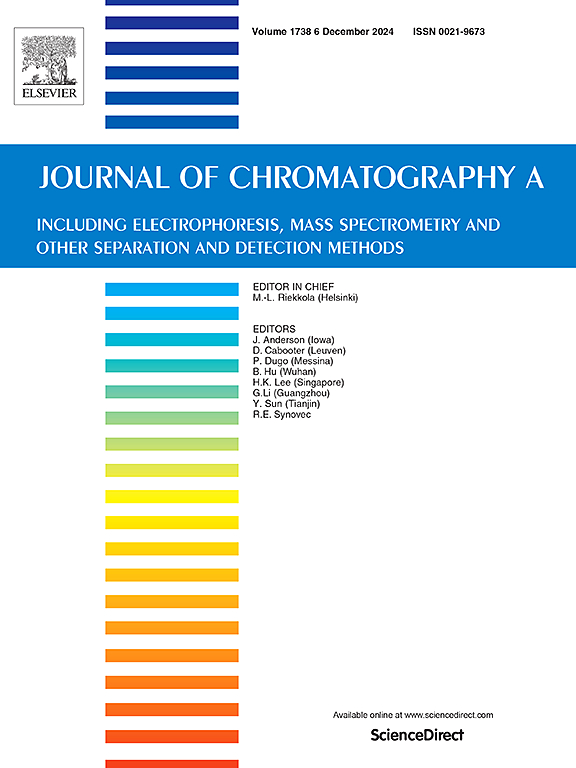SARS-CoV-2和Omicron疫苗从配体筛选到纯化的广谱亲和层析
IF 4
2区 化学
Q1 BIOCHEMICAL RESEARCH METHODS
引用次数: 0
摘要
新出现的SARS-CoV-2变种给疫苗生产,特别是下游加工带来了巨大的技术和监管挑战。为了解决这一难题,开发用于纯化野生型SARS-CoV-2及其变体的广谱亲和色谱至关重要。我们提出了一个综合的策略来实现这一目标,通过噬菌体展示和下一代测序(NGS)的亲和力选择和色谱性能评估来鉴定高亲和力肽。从富集的噬菌体文库中获得了两个靶向受体结合域(RBD)上血管紧张素转换酶2 (ACE2)结合基序的肽,HFVKTPARWAWG (SP-HFV)和HYRTSHWHHLLG (SP-HYR)。它们对RBD和三聚体刺突蛋白(Trimer S)表现出纳摩尔亲和力,并对来自变体的所有RBD具有广谱亲和力。分子动力学模拟揭示了SP-HFV和SP-HYR在ace2结合基序上的不同结合区域和参与结合的关键残基。将SP-HYR偶联到琼脂糖基质上后,色谱结果表明,野生型和Omicron变异的RBD和Trimer S在pH 6.0 ~ 6.5范围内均可吸附,并可通过增加盐浓度洗脱,表现出亲和色谱的广谱、温和洗脱特性。最后,将亲和层析法应用于SARS-CoV-2灭活疫苗和Omicron灭活疫苗的纯化,获得了较高的产率(84.5 ~ 93.0%)和纯度(81.3 ~ 98.0%),并具有很强的耐20次苛刻的就地清洗性能。这项工作清楚地证明了用于疫苗纯化的广谱亲和层析的商业潜力,以解决致病病毒的快速变化。本文章由计算机程序翻译,如有差异,请以英文原文为准。
Broad-spectrum affinity chromatography of SARS-CoV-2 and Omicron vaccines from ligand screening to purification
Emerging variants of SARS-CoV-2 pose great technological and regulatory challenges to vaccine manufacturing, especially in downstream processing. To address this dilemma, the development of broad-spectrum affinity chromatography for the purification of wild-type SARS-CoV-2 and its variants is crucial. We propose a comprehensive strategy to achieve this goal via the identification of high-affinity peptides by affinity selection of phage display and next-generation sequencing (NGS) and the evaluation of chromatographic performance. Two peptides targeting the angiotensin-converting enzyme 2 (ACE2)-binding motif on the receptor-binding domain (RBD), HFVKTPARWAWG (SP-HFV) and HYRTSHWHHLLG (SP-HYR), were obtained from the most abundant sequences of the enriched phage library. They exhibited nanomolar affinity for the RBD and trimeric spike protein (Trimer S), and had broad-spectrum affinity for all the RBDs from the variants. Molecular dynamics simulations revealed the different binding regions of SP-HFV and SP-HYR in the ACE2-binding motif and key residues contributing to binding. After SP-HYR was coupled onto agarose matrices, chromatographic results showed that the RBD and Trimer S from the wild-type and Omicron variant could be adsorbed at pH 6.0–6.5 and eluted by increasing the salt concentration, exhibiting broad-spectrum and mild-elution characteristics of affinity chromatography. Finally, the affinity chromatography was applied for the purification of inactivated SARS-CoV-2 and Omicron vaccines, affording high yields (84.5–93.0 %) and purities (81.3–98.0 %), and great resistance to harsh cleaning-in-place in 20 cycles. This work clearly demonstrated the commercial potential of broad-spectrum affinity chromatography for vaccine purification to address the rapid variation of pathogenic viruses.
求助全文
通过发布文献求助,成功后即可免费获取论文全文。
去求助
来源期刊

Journal of Chromatography A
化学-分析化学
CiteScore
7.90
自引率
14.60%
发文量
742
审稿时长
45 days
期刊介绍:
The Journal of Chromatography A provides a forum for the publication of original research and critical reviews on all aspects of fundamental and applied separation science. The scope of the journal includes chromatography and related techniques, electromigration techniques (e.g. electrophoresis, electrochromatography), hyphenated and other multi-dimensional techniques, sample preparation, and detection methods such as mass spectrometry. Contributions consist mainly of research papers dealing with the theory of separation methods, instrumental developments and analytical and preparative applications of general interest.
 求助内容:
求助内容: 应助结果提醒方式:
应助结果提醒方式:


